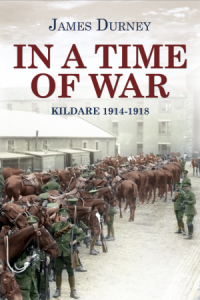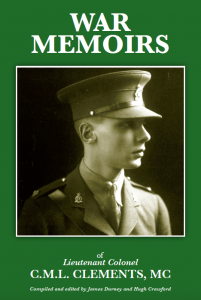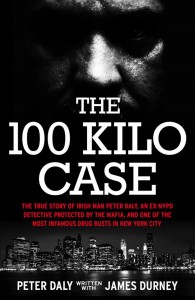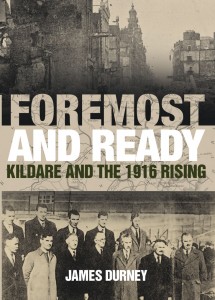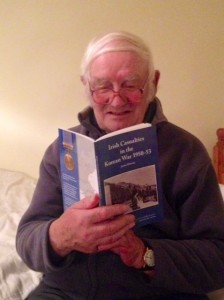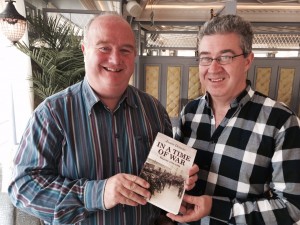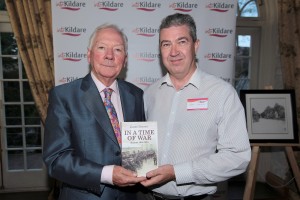The brothers O’Kelly, Leinster Leader editors
James Durney
Galway-born brothers, Séumas and Michael O’Kelly, were both editors of the Leinster Leader during Ireland’s revolutionary period. Séumas was editor from 1906-1912, while Michael replaced his brother as editor when Séumas moved to Dublin. Subsequently, when Michael was interned, in the aftermath of the 1916 Rising, Séumas briefly replaced him until Michael was released from custody a few weeks later. The editorship of the Leinster Leader was Séumas O’Kelly’s longest single journalistic connection.
Michael O’Kelly was born Michael Kelly, on 18 February 1873, in Loughrea, Co. Galway, to Michael Kelly and his wife, Catherine Fitzgerald. Sponsors were John Fitzgerald and Bridget Morris. Séumas O’Kelly was born James Kelly, in Mobhill, Loughrea, Co. Galway, on 16 November 1875, the youngest of seven children. Sponsors were Martin and Honora Kelly. On 22 October 1905 Catherine Kelly took ill while saying the Stations of the Cross, in Loughrea Cathedral, and died the next day.
Writing in June 1919, in a preface to his brother’s play, The Parnellite, Michael O’Kelly wrote about the origins of the O’Kelly’s:
‘Born at Loughrea, Co. Galway, the early life of Séumas O’Kelly was passed in an environment that strongly permeated all his work. His forebears on the paternal side were for many generations identified with the milling and corn-carrying trade, which in the past flourished between Limerick and Galway … The father of Seumas for many years carried on a prosperous business in Loughrea. Seumas’s mother was Catherine Fitzgerald of Foxhill, in the same locality, a family name now extinct, and only the very old remember the Fitzgeralds of Foxhill, noted for their generous hospitality.’
From the 1880s Loughrea was at the centre of agitation by the Land League’s ‘Plan of Campaign’ on the Clanricarde estate. Many tenants in Loughrea and surrounding rural districts were evicted for non-payment of rent, and Lord Clanricarde resisted their reinstatement until the estate was purchased by special legislation shortly before the Great War. Michael O’Kelly later wrote that his father was ‘one of the sufferers amongst the evicted tenants of the Clanricarde estate,’ and the scenes which Séumas ‘witnessed in his early years left a deep and lasting impression on his mind’. According to one local story the Kellys were evicted from their holding during the Plan of Campaign, though they seemed to have retained a degree of financial stability. Michael Kelly opened a newsagents shop in Loughrea and was able to provide a good level of education for his children.
In the 1901 Census Michael Kelly’s occupation was given as ‘Newsagent.’ His address at Mobhill, Loughrea, was recorded as a shop on the B1 Form. He was sixty years of age and his wife, Catherine (56), and daughter, Nora, (26) are also recorded as being newsagents. Sons Michael (23) and James (21) are recorded as ‘journalists.’ A grandson, Alphonsus Sweeney (8), was also recorded. Ten years later, in the 1911 Census, Michael (34) had changed his name to O’Kelly and was a boarder in a house on Dublin Road, Nenagh, Co. Tipperary. His occupation was given as a journalist and his language proficiency recorded as ‘Irish and English’. In 1911 Séumas was living in Naas, Co. Kildare, in a cottage rented from Mrs. Norton. The census form was completed and signed in Irish with the head of family signature being given as Mícéal Ua Ceallaig (72). Also recorded was Nóra Ní Ceallaig (daughter, aged thirty), Séumas Ua Ceallaig (son, aged twenty-eight) and Alponsus Mac Suibne (nephew, aged ten). Both Mícéal and Séumas are recorded as having ‘gaelig and bearla’, while Nóra and Alponsus have ‘bearla’ only. However, Alponsus Mac Suibne is recorded as being a nephew, so it is obvious that Séumas, and not Mícéal, filled in the census form.
While growing up in Loughrea, Séumas was influenced in his viewpoint by contact with older relatives and country people from whom he learned some Irish and the folklore/storytelling tradition that shaped many of his stories and writings. Much of his writings are recognisably set in Loughrea and the West of Ireland. His strong commitment to Catholicism was acquired from his deeply religious mother and his service as an altar boy with the local Carmelite fathers. Séumas began working as a journalist on local papers, including the Midland Tribune, the Tuam News, and the Connacht Leader. When he took over the Southern Star, based in Skibbereen, Co. Cork, in 1903, he became the youngest newspaper editor in Ireland. Despite his editorship and newspaper experience it took him some time to make any impact as a writer.
Séumas moved to Naas, Co. Kildare, in 1906, to take up the post of editor of the Leinster Leader. He lived first in the town’s Main Street, but then in ‘Abbeyville’ a four-chimney house by the Grand Canal, which provided the inspiration for his linked series of short stories, The Golden Barque. That same year he published his first major work, By the stream of Kilmeen, a collection of short stories and sketches. The following year his one-act comedy, The Matchmakers, was produced by the Theatre of Ireland at the Abbey Theatre. Then came The Flame on the Hearth (1908), but it was not until The Schuller’s Child was presented in 1909, at the Rotunda, that he first experienced popular acclaim.
He brought his father, his sister Nora, and his nephew, Alphonsus Sweeney, to live with him in Naas, in 1907. Meanwhile, he had founded a local branch of the Gaelic League, became an early member of Naas Sinn Féin, and played host to many visitors, including Countess Markievicz, who attended the yearly June commemorations at Wolfe Tone’s grave in nearby Bodenstown. His journalistic career was accompanied by his development as a writer, publishing stories in a variety of outlets, including the Irish Rosary and the Irish Packet. He eventually became master of the short story form.
Séumas had always been nationalistic and conscious of the many injustices in Ireland at the time and was a contributor to the United Irishman, published by Arthur Griffith – who had been a compositor in the Leinster Leader’s rival paper, the Kildare Observer, also published in Naas. Séumas made regular weekend visits to Dublin, where Griffith introduced him to Dublin literary circles, including Seamus O’Sullivan, who described Séumas as ‘a stoutly-built little man … who seemed to me, at first sight, to be the most good-natured-looking person I had ever seen’.
Around 1911, Séumas suffered a severe attack of rheumatic fever, which left him with a chronic heart condition. He continued to write extensively and with increasing skill publishing verse and short stories; he collaborated with Count Casimir de Markievicz on the one-act play Lustre. Séumas became editor of the Dublin Saturday Evening Post in 1912 and moved to Dublin, where he lived in Drumcondra. His editorship at the Leinster Leader was taken up by his brother, Michael. Séumas attended the inaugural meeting of the Irish Volunteers, with his nephew, in November 1913, at the Rotunda. Around the same time that he moved to Dublin Séumas began writing a series of Irish sketches for the Manchester Guardian, turning down a permanent job on the paper. Shortly afterwards Miss A. E. Hornridge, the Abbey benefactress, asked him to write a play suitable for an English audience. He wrote Driftwood, which was produced at the Gaiety Theatre, Manchester, in October 1915, and the following January it opened at the Duke of York Theatre, London.
The success of this work prompted London publishers to take note, for the following year Metheun published his first novel The Lady of Deerpark. From that onwards much of his work was published in London and New York and his literary reputation continued to grow. One such work, The Weaver’s Grave,’ is regarded throughout the world as a masterpiece. It is the best-known and most translated and broadcast of O’Kelly’s work.
Séumas O’Kelly left the Evening Post in 1915 because of continuing ill-health. He was offered the editorship of the Sunday Freeman, but had to retire after two weeks and returned to live in Naas, in January 1916. When Michael O’Kelly was arrested and interned after the Easter Rising he resumed the editorship of the Leinster Leader until his brother’s release in June 1916, his work complicated by his having to get all controversial articles passed by the censor in Dublin Castle.
The strongly nationalistic views of editor, Michael O’Kelly, were reflected in the Leinster Leader, especially in reports concerning the British army and its war effort. In October 1914 O’Kelly wrote a long editorial on ‘Ireland and the war’ in which he attacked the ‘unholy lust of capitalism and others’ and argued that Ireland’s quarrel was with Britain and not Germany. He became President of Naas Sinn Féin Club and Officer Commanding Naas Company, Irish Volunteers. In early 1916 a meeting was held in Michael O’Kelly’s home at Gleann na Greine, Naas, to prepare for local action in support of a general rising planned for Easter week. Eoin MacNeill’s countermanding order generated huge confusion and very few Volunteers mobilized for action at Easter 1916.
In the aftermath of the Rising there were some local arrests and Michael O’Kelly and his nephew, Alphonsus Sweeney, were among those picked up. O’Kelly was imprisoned in the Glasshouse, at the Curragh and Richmond Barracks, Dublin. He was deported on 8 May and interned in Wandesworth Detention Camp and Wakefield Barracks, England. In early June 1916, after a month in detention, he was released and resumed editorship of the Leinster Leader in August.
Séumas O’Kelly continued to live in Naas until May 1918 when Arthur Griffith was arrested and deported during the German Plot scare. Despite his failing health, Séumas assumed editorship of Nationality. During celebrations after the Armistice of November 1918 a crowd of soldiers and separation women attacked the paper’s premises, which were also the headquarters of Sinn Féin. O’Kelly feebly defended himself with his walking stick, but suffered a cerebral hemorrhage, which led to his death in Jervis Street Nursing Home, Dublin, on 14 November 1918. His funeral to Glasnevin Cemetery, Dublin, turned into a major political demonstration and his status as a nationalist martyr led to the posthumous publication of many of his works.
The procession which started at noon from the Church of St. Teresa, Clarendon Street, was of imposing proportion, while along the route to the cemetery the streets were thronged with spectators. Previous to the removal of the remains from the church Requiem Mass for the spiritual repose of the deceased was celebrated by his brother, the Rev. Father Alphonsus O’Kelly, O.D.C. Wreathes were received from the Sinn Fein Executive, the staff of Nationality, the staff of the Leinster Leader, the Co. Kildare Gaelic League Executive, and Naas (Seán Connolly) Sinn Fein Club. The fife and drum band of the Dublin Builders’ United Labourers’ Trades Union, the Ashbourne Irish pipers’ band and the Sinn Féin Irish pipers’ band played slow music as the funeral wended its way through principal streets of the city. In the cortege were Cumann na mBan and other women’s organizations, Sinn Fein clubs, Fianna boys, Gaelic Leaguers, and the general public. The pathways in the cemetery were lined by Volunteers, who were formally dismissed by their officers, when the internment had been completed. Some two hundred police were stationed in the vicinity of Glasnevin.
Séumas O’Kelly was unmarried, but he is said to have cherished a hopeless passion for the actress and republican activist, Máire Nic Shiubhlaigh (Mary Walker), for whom he wrote the play, The Shuiler’s Child (1909). She was a founder member of the Abbey theatre and was leading lady on its opening night in 1904. As a member of Cumann na mBan Nic Shiubhlaigh was at Jacob’s Factory in Easter Week 1916. She married former IRA Director of Organisation, Eamon Price, in 1929, and died in 1958.
Michael O’Kelly remained a prominent republican activist throughout the revolutionary period. At Naas Petty Sessions he was sentenced to a week in Mountjoy Jail, in March 1918, for ‘unlawfully’ selling potatoes without having a licence from the British Food Controller. After the evidence was given Michael O’Kelly said, ‘I do not recognise the jurisdiction of this court at all. I am a citizen and soldier of the Irish Republic, and don’t recognise this court.’ O’Kelly was interned in the Rath Camp in 1921 until the General Amnesty in December; he was interned again during the Civil War, in Newbridge Barracks, in 1923.
In later life he moved to Dublin and worked with the Irish Independent. He lived at 76 Upper George’s Street, Dun Laoghaire. Michael O’Kelly died in December 1955, aged eighty-two. His funeral took place to Glasnevin Cemetery, following Requiem Mass in the Church of St. Teresa, Clarendon Street, from where his brother’s remains had left thirty-seven years earlier. Military honours were accorded by a unit of the Defence Forces; Naas Company, Old IRA, was represented by a former comrade, Patrick O’Carroll. The attendance included his nephew, Alphonsus Sweeney (Dun Laoghaire), and M. F. Linnane, Chief Reporter for the Irish Independent.
Unfortunately, Séumas O’Kelly has been neglected in his own country, whereas abroad he has been the subject of thesis, treatise and translation. It was only many years after his death that Séumas O’Kelly received greater eminence than he received when he was alive. The twenty-fifth and fiftieth anniversaries of his death saw various commemorations in his honour. In 1968 a short-lived ‘Séumas O’Kelly Society’ was formed, in Dublin, to perpetuate his memory. The following year on 5 December 1970 Gill and Macmillan published A land of loneliness, a select body of O’Kelly’s writings edited and introduced by Eamonn Grennan, of Harvard University. George Brandon Saul penned a monograph for ‘The Irish Writers Series’ (Bucknell University Press, 1971). Seumas O’Kelly is remembered too, in Naas, with a plaque on Leinster Leader house on which there is inscribed the tribute: ‘A gentle revolutionary.’
